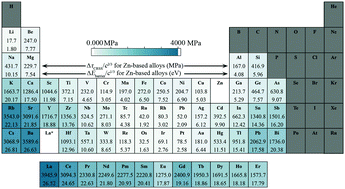A generalized solid strengthening rule for biocompatible Zn-based alloys, a comparison with Mg-based alloys†
Abstract
Solid solution strengthening has been widely used in designing various high-performance biocompatible Mg-based alloys, but its transferability to other biocompatible metals such as Zn-based alloys is questionable or nearly absent. In the present study, an ab initio informed Peierls–Nabarro model and Leyson et al.'s strengthening model are used for a systematic investigation on solute strengthening in Zn-based alloys, which is compared with the widely studied Mg-based alloys. Although an inverse relationship was revealed between volume misfit εb and chemical misfit εSFE for both Zn-based and Mg-based alloys, most solutes would however result in positive εb and negative εSFE for Zn-based alloys, differing from Mg-based alloys. With εb and εSFE as two key descriptors, a generalized scaling diagram is finally drawn for a fast evaluation of solid solution strengthening in Zn-based alloys, indicating that the alkaline-earth and rare earth elements are better strengtheners for Zn-based alloys, which provides a general rule in designing novel biocompatible materials.



 Please wait while we load your content...
Please wait while we load your content...